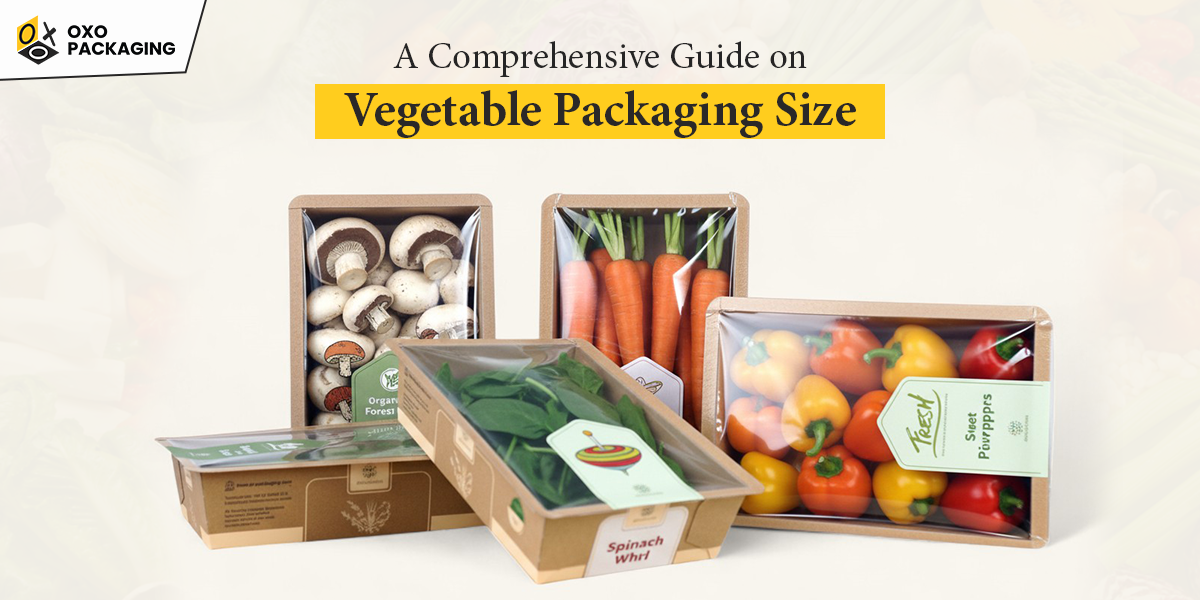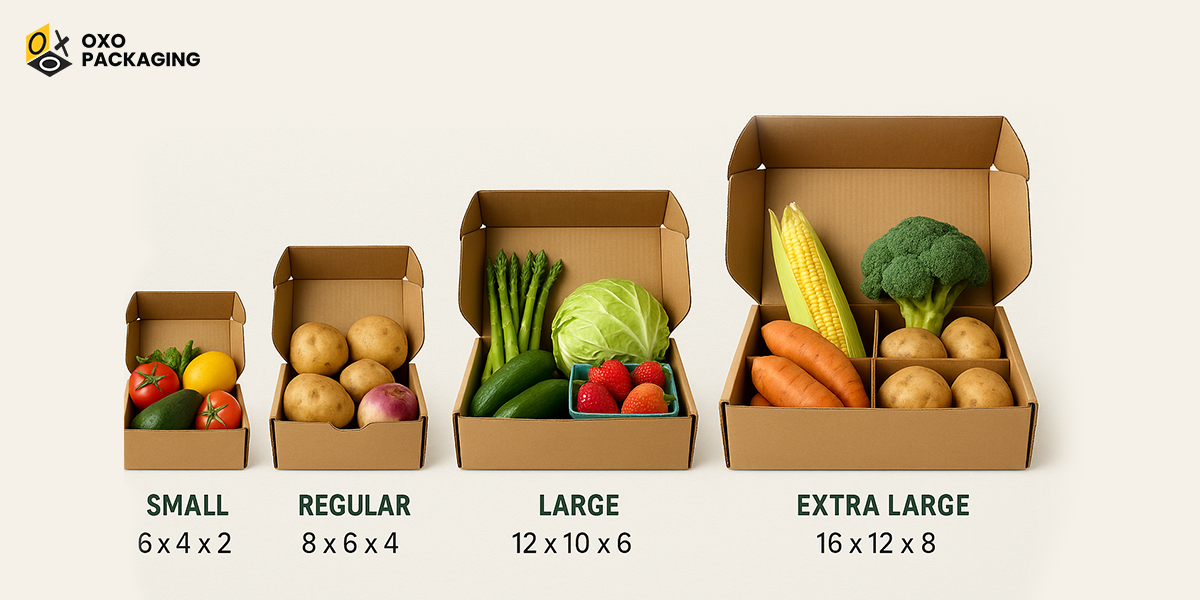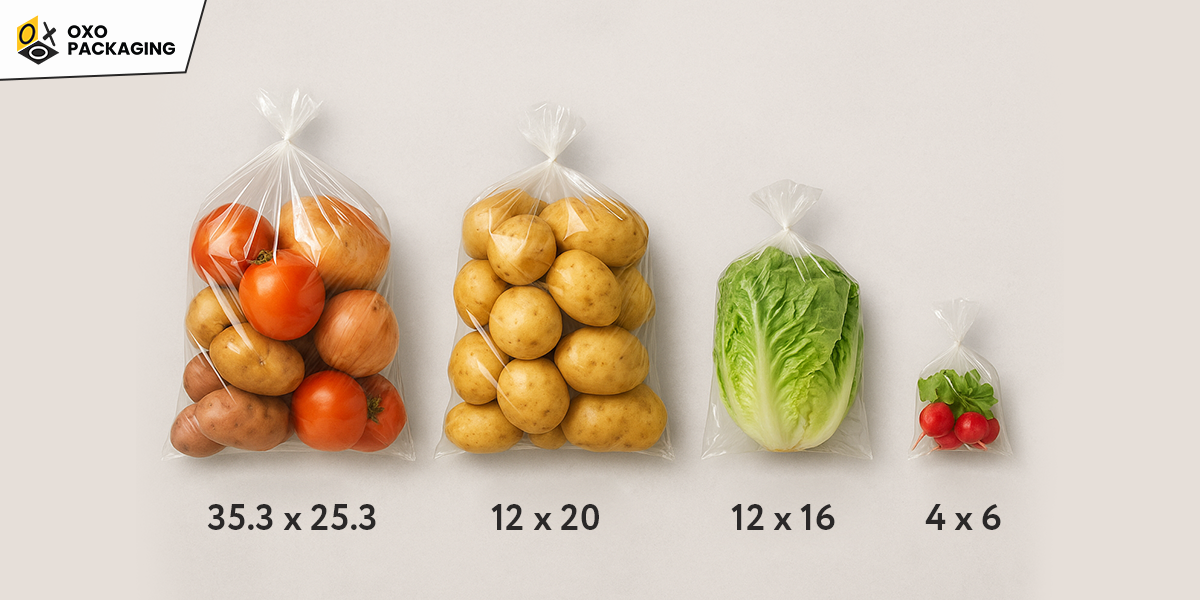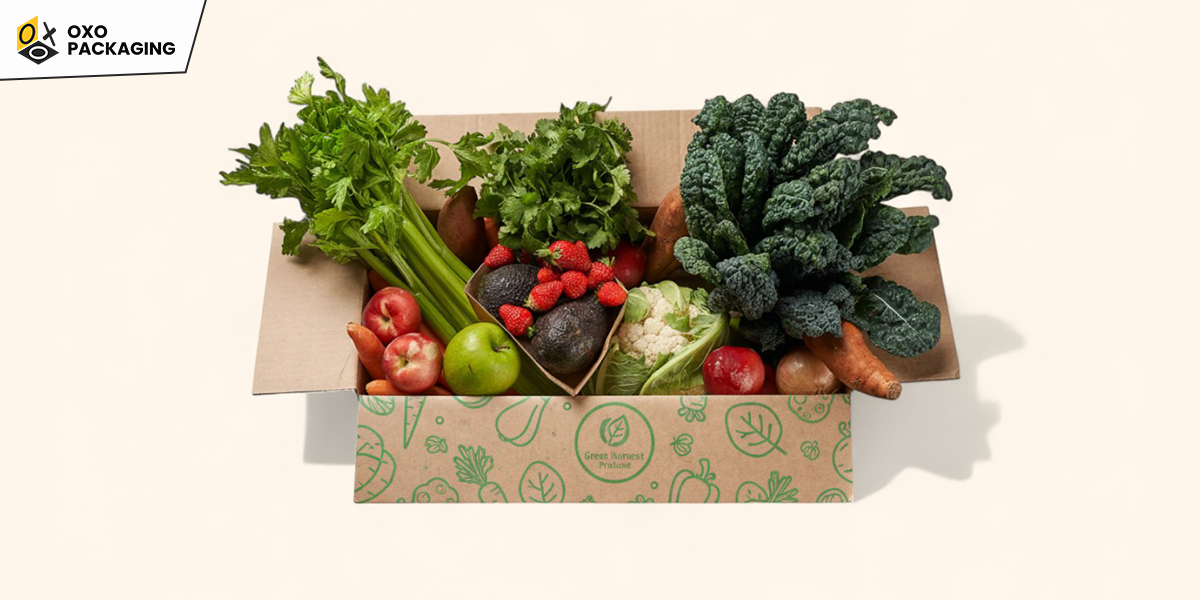A Comprehensive Guide on Vegetable Packaging Size

From ancient to modern times, the demand for fresh produce has always been a priority for consumers. Compared to past times, packaging has made it quite easy to maintain the freshness and quality of vegetables and boost overall customer satisfaction.
Choosing the right size of vegetable boxes and bags plays a significant role in their freshness and shelf life. This blog provides detailed guidance on vegetable packaging size for boxes and bags. Read on to elevate your vegetable packaging!
Standard Sizes of Vegetable Boxes

Let’s jump right into standard packaging sizes for vegetable boxes. There are versatile sizes for these boxes, from small to extra large. You can measure three dimensions of vegetable boxes in the order (L × W × H). Consider these sizes to choose the right one based on your needs:
Regular Size
The regular size of a vegetable box is 8" x 6 "x 4" inches. It means you can pack seven varieties of local, organic, and seasonal vegetables in this-sized box. Commonly, vegetables, including onions, potatoes, turnips, cabbage, and leeks, are popular choices to pack in regular-sized boxes.
Large Size
12" x 10" x 6" inches is the standard size for large vegetable boxes. This spacious size is enough for storing bulk vegetables while preserving their freshness and flavor. You can pack asparagus, berries, sweet potatoes, and cucumbers in these boxes.
Extra Large Size
If you are seeking a size that ensures your vegetables stay intact and remain fresh for a longer period during shipping, opt for the extra extra-large size. 16" x 12" x 8" inches are extra-large-sized vegetable boxes, which are big enough to have organized inserts.
Small Size
To ensure vegetables and fruits fit snugly and remain undamaged from falling or moving during shipping, consider a small box size. Chillies, tomatoes, lemon, avocado, lettuce, and cucumber are ideal to pack in a 6" x 4" x 2" box.
Standard Sizes of Vegetable Bags

Now that you have explored the sizes of vegetable boxes in detail, it’s time to consider standard sizes for vegetable bags. With the order (W x H), you can measure the dimensions of these bags. Well, keep in mind that bag sizes for produce vary, but here are popular sizes for commercial produce:
Standard vegetable bag sizes vary, but common sizes include 12" x 16" for general use, 15" x 20" for commercial produce, and 10" x 18" for larger items like lettuce. Smaller bags, like 8" x 10" or 3" x 3", are used for items like herbs, mushrooms, and grapes. Larger bags, up to 24" x 48", are available for things like potatoes and onions.
Regular Size
The most common size is a 12″ x 16″ bag. This size is large enough to hold most vegetables and fruits. Potatoes, onions, tomatoes, sweet potatoes, and winter squashes are commonly packed inside regular-sized bags.
Iarge Size
A large-sized vegetable bag varies by purpose. But common large sizes are 12″ x 20″ bags. However, large grow bags with 20 gallons can be approximately 12″ x 30″ inches. You can also place larger and deep-rooted plants in these bags.
Extra Large Size
For produce storage, extra-large mesh bags can be around 35.3 x 25.3 inches. Various types of produce, including potatoes, tomatoes, melons, cucumbers, and squash, are commonly packed inside extra-large vegetable bags.
Small Size
Small-sized vegetable bags often refer to 4 x 6 inches. Garlic, small onions, shallots, parsley, cilantro, mint, cherry tomatoes, chili peppers, or a small bunch of radishes are commonly packed in this-sized bag.
Recommended Vegetable Packaging Guidelines
Various factors, such as vegetable type, supply chain logistics, and market preferences, play an important role in choosing the ideal vegetable packaging size. However, size recommendations can vary due to these factors, but some reputable sources provide guidelines to help make informed decisions for selecting vegetable packaging size. Have a look at them:
USDA Standards
The United States Department of Agriculture (USDA) provides specific standards for the packaging size of vegetables and fruits. It recommends 100 or 110-inch cartons for packaging 50 pounds of produce. However, vegetable bags should be 2 inches for carrying 50 pounds of vegetables.
PMA Guidelines
The Produce Marketing Association (PMA) emphasizes the importance of choosing appropriate packaging sizes for vegetables. It suggests that bulk vegetables like potatoes and onions should be packed in perforated boxes ranging from 5 to 10 pounds.
Factors to Consider When Choosing Right Vegetable Packaging Size
There are certain factors to consider when it comes to choosing the right size for vegetable packaging boxes and bags. Have an overview of them:
Materials
The selection of the right material ensures your vegetables stay fresh and unspoiled. For crafting your vegetable boxes, you may choose kraft, cardboard, corrugated while jute, and tote materials to manufacture vegetable bags. All these materials provide sturdiness and moisture resistance to deliver vegetables freshly during shipping.
Shapes
Mindfully consider appropriate shapes for vegetable bags and boxes. Commonly used shapes for boxes are rectangular, square, and cube. However, square and cylindrical shapes are popular for vegetable bags. You can easily align these shapes according to the desired sizes of vegetables and fruits. You can also try innovative shapes by leveraging the power of custom packaging.
Styles
When it comes to picking packaging styles, you must choose one that aligns with your selected sizes. Some popular styles like Flat-Pack, Hinged, Tuck-End, Two-Piece, and Clamshell complement the size of vegetables. These styles are not only aligned with the packaging size of your vegetable boxes and bags but also enhance your brand appeal.
Importance of Right-Size Vegetable Packaging
Going with the right-sized vegetable packaging can make or break your business reputation. Explore different reasons not to underestimate the right size for vegetable boxes and bags:
Maintain Freshness and Quality: Prevent excessive air exposure, which causes spoilage and dehydration of produce. Vegetable boxes and bags also provide a cushioning effect to vegetables while preventing physical damage during shipping.
Prolong Shelf Life: Reduce exposure to harsh environmental factors that slow down the natural degradation process of produce. It benefits retailers by minimizing spoilage losses while ensuring consumers enjoy fresh produce.
Allow Cost-Effective Shipping: Optimize space utilization by avoiding oversized packaging that results in higher shipping and storage expenses. With right-size packaging, you can ship more units while reducing overall shipping costs.
Support Environmental Sustainability: Minimize the amount of material used, which leads to less waste production. It eventually leads to a lower carbon footprint that also aligns with eco-conscious market values.
A Step-by-Step Guide to Measure Right Size for Vegetable Packaging
To measure a vegetable box, measure its length (the longest side), width (the shorter side), and height (the side perpendicular to the other two) using a ruler or measuring tape. Always measure in the same order (length x width x height) to ensure consistency.
To measure the size of a vegetable bag, measure the width across the opening, the length from the bottom to the top opening, and the depth by fully extending any gussets. For the most common "flat" bags, use the formula width x length for the interior dimensions. For "gusseted" bags, which have expandable sides or a bottom, measure width x length x depth.
Why Vegetable Boxes are a Better Choice than Plastic Bags?

Vegetable boxes are better than plastic bags because they reduce environmental waste, offer greater freshness, provide flexibility in quantity, and support local farmers. Above all, they are often more sustainable.
Unlike single-use plastic bags that contribute to pollution, vegetable boxes can be reused while offering a more sustainable and environmentally friendly way to purchase and store produce.
What Vegetable Packaging Size Should You Choose?
Talking about choosing the right vegetable packaging size, there is no one-size-fits-all packaging size. Because the size of your vegetable boxes and bags really depends on their type, weight, quantity, and volume.
Hopefully, you have read this blog thoroughly to understand standard sizes and packaging size requirements in detail. It will help you choose the right packaging size for vegetable containers and bags. In case you want a perfect packaging size for your vegetable items, contact us today and get snugly-fit boxes and bags.
The best container size for vegetable gardening depends on the vegetable. But a general rule is that larger plants need larger pots. For most common vegetables, a pot that is at least 5 gallons.
For cucumbers, use a large container, at least 5 gallons (20 quarts) for a single bush plant or a container that is at least 12 inches wide and 10 inches deep for one vining plant.
The best container size for tomatoes depends on the variety, with determinate (bush) types needing at least a 5- to 10-gallon pot and indeterminate (vining) types requiring a larger 10- to 20-gallon container.
Vegetable packaging size varies. But common standard sizes include a regular box of 8"x6"x4", a large box of 12"x10"x6", and an extra-large box of 16"x12"x8".




